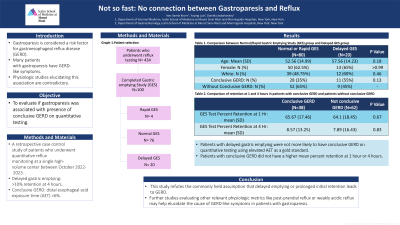Tuesday Poster Session
Category: Esophagus
P3942 - Not So Fast: No Connection Between Gastroparesis and Reflux
Tuesday, October 29, 2024
10:30 AM - 4:00 PM ET
Location: Exhibit Hall E

Has Audio

Ines Varela, MD
Mount Sinai West, Icahn School of Medicine at Mount Sinai
New York, NY
Presenting Author(s)
Ines Varela Knorr, MD1, Yuying Luo, MD2, Daniela Jodorkovsky, MD2
1Mount Sinai West, Icahn School of Medicine at Mount Sinai, New York, NY; 2Mount Sinai Center for Gastrointestinal Physiology & Motility, New York, NY
Introduction: Gastroparesis is considered a risk factor for gastroesophageal reflux disease (GERD) and many patients with gastroparesis have GERD-like symptoms. However, physiologic studies elucidating this association are contradictory. We aimed to evaluate if gastroparesis was associated with presence of conclusive GERD on quantitative testing.
1Mount Sinai West, Icahn School of Medicine at Mount Sinai, New York, NY; 2Mount Sinai Center for Gastrointestinal Physiology & Motility, New York, NY
Introduction: Gastroparesis is considered a risk factor for gastroesophageal reflux disease (GERD) and many patients with gastroparesis have GERD-like symptoms. However, physiologic studies elucidating this association are contradictory. We aimed to evaluate if gastroparesis was associated with presence of conclusive GERD on quantitative testing.
Methods: We conducted a retrospective case control study of patients who underwent quantitative reflux monitoring at a single high-volume center between October 2022- 2023. Patients were stratified by gastric scintigraphy results, with delayed gastric emptying defined by >10% retention at 4 hours. Conclusive GERD was defined by distal esophageal acid exposure time (AET) >6%. Data collected included age, gender, ethnicity, and percent retention at 1-4 hours. The primary outcome was percentage of patients with conclusive evidence of GERD. Statistical analysis was performed using Fischer exact test and unpaired T-test.
Results: Of 434 individuals identified, 100 underwent gastric emptying studies (GES) with n=63 (63%) female and average age of 53.56 years. 80 patients had a normal or rapid GES (4 with rapid) and 20 patients had a delayed GES. The two groups did not differ significantly with respect to age (“normal or rapid GES” 52.56 vs “delayed GES” 57.56; p= 0.1815), proportion of females (“normal or rapid GES” 62.5% vs “delayed GES” 65%; p >0.999) or ethnicity (“normal or rapid GES” 48.75% white vs “delayed GES” 60% white; p=0.4562). More individuals with delayed GES had conclusive GERD (55%) compared with those with normal or rapid GES (35%); however, this was not statistically significant (p=0.13) (Table 1). The mean percent retention at 1 and 4 hours was 65.67% versus 64.1% (p=0.67) and 8.57% versus 7.89% (p=0.83) for the conclusive GERD and without GERD groups respectively.
Discussion: Patients with delayed gastric emptying were not more likely to have conclusive GERD on quantitative testing using elevated AET as a gold standard. We also did not find a higher percent retention at 1 hour or 4 hours in patients with conclusive GERD. This study refutes the commonly held assumption that delayed emptying or prolonged initial retention leads to GERD. Further studies evaluating other relevant physiologic metrics like post-prandial reflux or weakly acidic reflux may help elucidate the cause of GERD-like symptoms in patients with gastroparesis.
Note: The table for this abstract can be viewed in the ePoster Gallery section of the ACG 2024 ePoster Site or in The American Journal of Gastroenterology's abstract supplement issue, both of which will be available starting October 27, 2024.
Disclosures:
Ines Varela Knorr indicated no relevant financial relationships. Yuying Luo indicated no relevant financial relationships. Daniela Jodorkovsky: Atmo Biosciences – Consultant.
Ines Varela Knorr, MD1, Yuying Luo, MD2, Daniela Jodorkovsky, MD2. P3942 - Not So Fast: No Connection Between Gastroparesis and Reflux, ACG 2024 Annual Scientific Meeting Abstracts. Philadelphia, PA: American College of Gastroenterology.
Note: The table for this abstract can be viewed in the ePoster Gallery section of the ACG 2024 ePoster Site or in The American Journal of Gastroenterology's abstract supplement issue, both of which will be available starting October 27, 2024.
